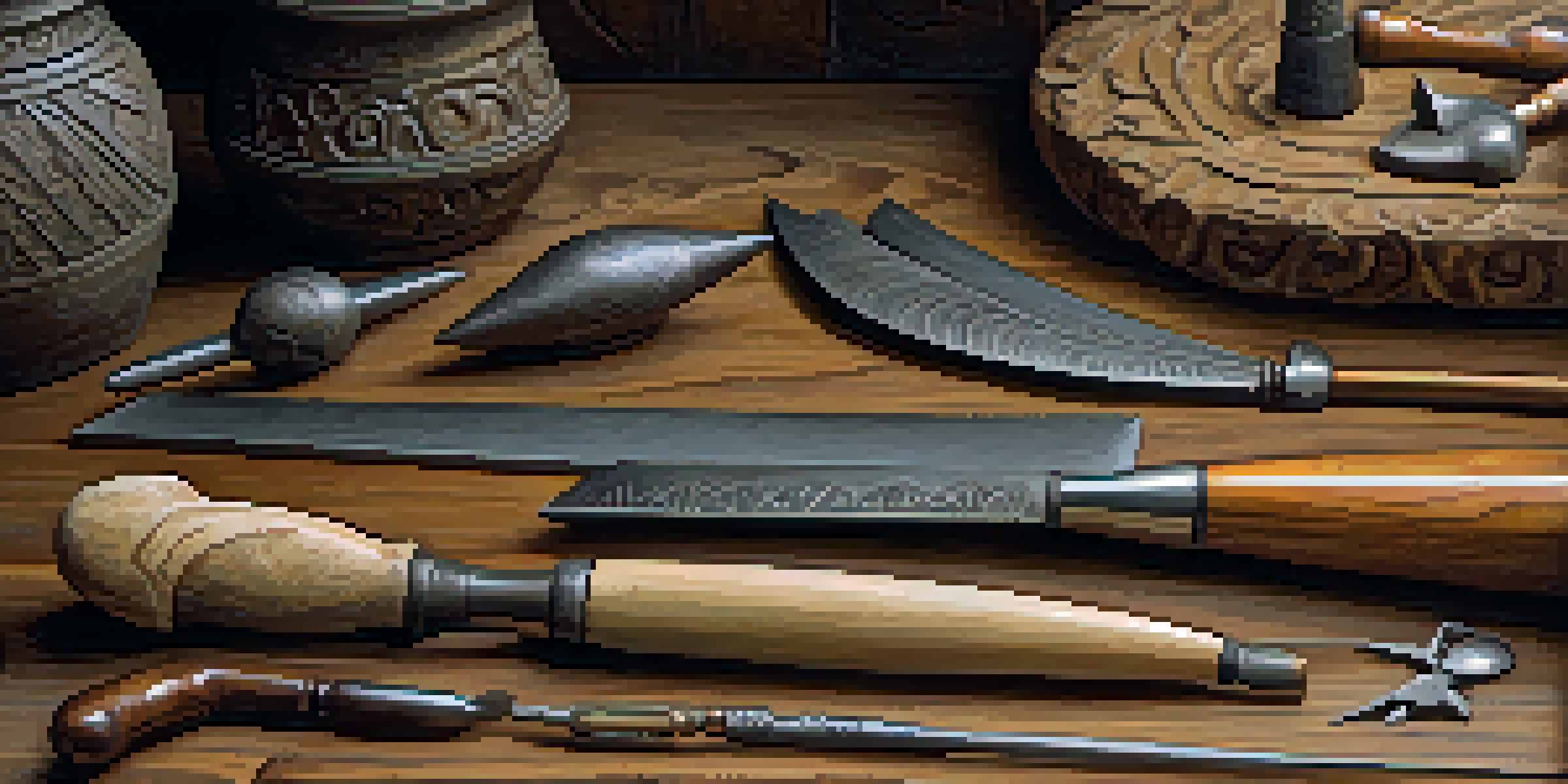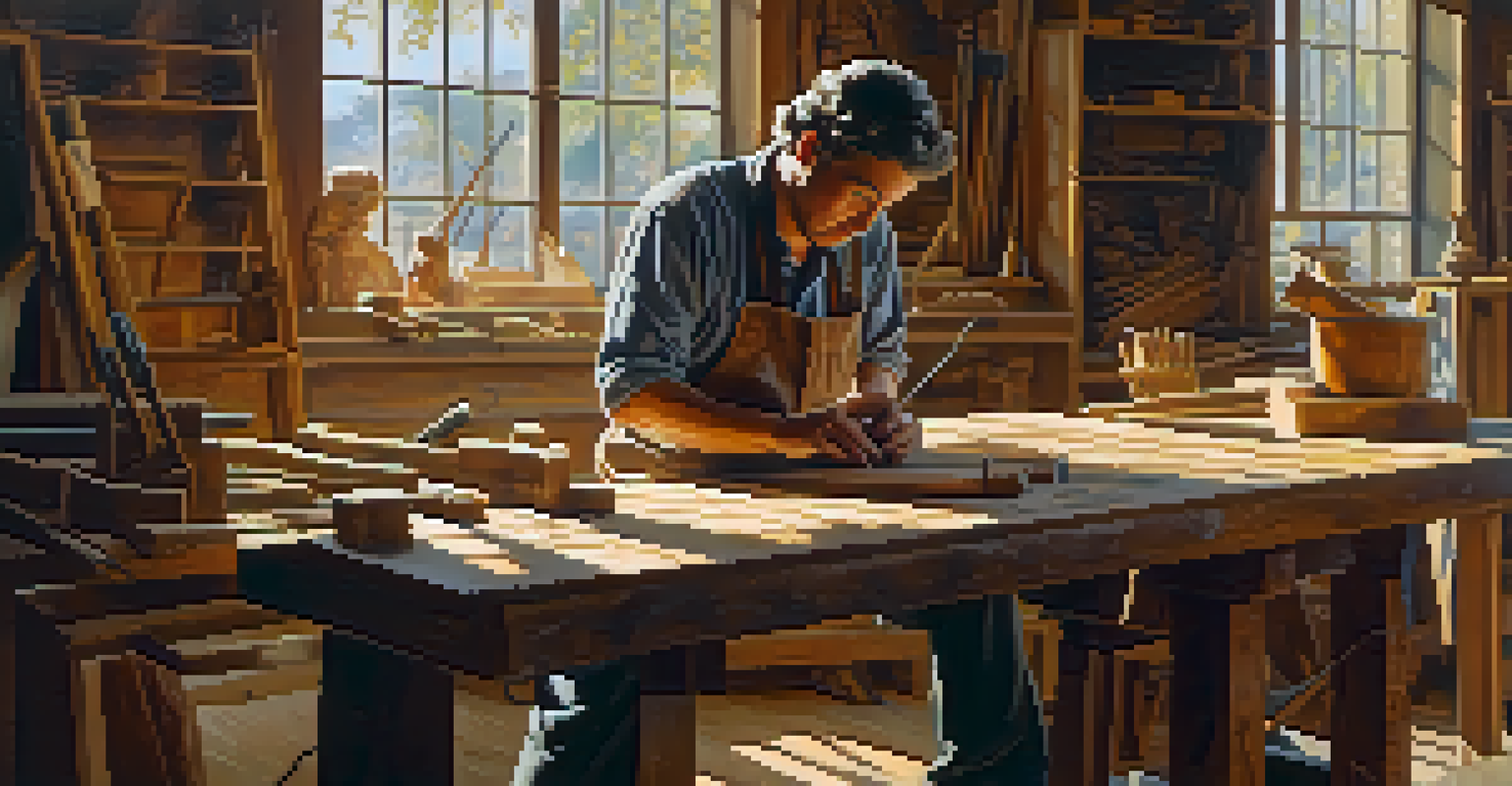Carving Tools Through History: Evolution and Usage

The Origins of Carving Tools in Prehistoric Times
Carving tools have a rich history that dates back to prehistoric times. Early humans relied on simple stone tools, such as flint and obsidian, to create tools for carving wood and bone. These rudimentary tools marked the beginning of human creativity, allowing our ancestors to produce basic art and functional objects.
Art is the most beautiful of all lies.
The significance of these early carving tools cannot be overstated; they were essential for survival. For instance, carving tools were used to create weapons for hunting and tools for food preparation. This innovation laid the groundwork for more complex societal structures, showcasing the link between tool-making and human development.
As time progressed, these primitive tools evolved, leading to the introduction of metalworking. The transition from stone to metal represented a significant leap in carving technology, enabling artisans to create more intricate designs and durable tools. This evolution highlights how necessity drives innovation throughout history.
The Rise of Wood Carving in Ancient Civilizations
As civilizations advanced, wood carving became an essential craft in many cultures, from the Egyptians to the Chinese. Ancient Egyptians crafted intricate wooden sculptures and furniture, often employing specialized chisels and knives. These tools were not just practical; they were also symbols of status and artistry, reflecting the culture's values and beliefs.

In ancient China, wood carving evolved into a highly respected art form, with artisans using tools like gouges and chisels to create intricate designs. The craftsmanship of these artisans helped shape cultural identity and played a significant role in religious and decorative practices. The tools they used were often adorned and passed down through generations, emphasizing their importance.
Evolution of Carving Tools
Carving tools have evolved from simple stone instruments in prehistoric times to sophisticated tools that reflect advancements in craftsmanship and technology.
The techniques developed during this period laid the foundation for future generations of carvers. Ancient texts and artifacts reveal a wealth of knowledge about different carving methods and tools, showcasing the artistry and skill of these early craftsmen. This era highlights the importance of carving tools not only for functionality but also as a means of cultural expression.
Medieval Innovations: The Growth of Specialized Tools
The medieval period saw a surge in the craftsmanship of carving tools, with specialized tools emerging for various applications. Woodworkers and sculptors began using more sophisticated implements, like the whittle knife and various gouges, to achieve finer details. This era marked a shift towards a more professional approach to woodworking and carving, with guilds forming to regulate standards.
Every artist dips his brush in his own soul, and paints his own nature into his pictures.
During this time, the development of the lathe revolutionized wood carving. This tool allowed artisans to create symmetrical pieces with greater ease, leading to the production of intricate designs for furniture and decorative items. The lathe's introduction not only improved efficiency but also expanded the creative possibilities for carvers.
The craftsmanship of the medieval period laid the groundwork for the Renaissance, where art and science converged. The skills and techniques honed during this era influenced future generations, contributing to a rich legacy of woodworking and carving that persists today. Specialized tools became essential for artists, pushing the boundaries of what could be achieved with wood.
The Renaissance: A Flourishing of Carving Techniques
The Renaissance was a pivotal time for the arts, including wood carving, as artists sought to revive classical techniques and innovate new ones. Carvers began to experiment with deeper relief and more intricate patterns, using tools like the V-tool for finer details. This period emphasized realism and expression, leading to masterpieces that showcased the skill of the artisans.
Famous artists such as Michelangelo and Donatello utilized advanced carving tools to create iconic sculptures that remain celebrated today. Their work demonstrated the potential of wood as a medium for expressive art, rather than merely practical objects. The tools they employed were a blend of traditional methods and new inventions, reflecting the spirit of innovation during the Renaissance.
Cultural Significance of Carving
Throughout history, carving tools have symbolized craftsmanship and identity, serving not just functional purposes but also embodying cultural stories and traditions.
The techniques developed during this time have had a lasting impact on the field of carving. The emphasis on artistic expression and technical precision set standards that continue to influence contemporary woodworkers. The Renaissance truly highlighted the artistry of carving tools, transforming them into a bridge between craftsmanship and fine art.
The Industrial Revolution and Mass Production of Tools
The Industrial Revolution brought significant changes to the production of carving tools, making them more accessible to the general public. Mass production techniques allowed for the creation of standardized tools, such as chisels and knives, at a lower cost. This democratization of tools led to a surge in woodworking and carving as hobbies and professions.
With the advent of new materials and manufacturing processes, carvers could choose from a wider range of tools. Steel replaced iron as the primary material for blades, resulting in sharper and more durable tools. This shift not only improved the quality of the tools but also inspired a new generation of craftsmen to experiment with their artistic abilities.
Despite the rise of factory-made tools, traditional craftsmanship persisted. Many artisans continued to handcraft their tools, valuing the personal touch and quality that mass production could not replicate. This era marks a significant turning point where modern techniques began to coexist with age-old traditions, shaping the future of carving.
Modern Carving Tools: Technology Meets Tradition
Today, carving tools continue to evolve with advancements in technology, blending traditional methods with modern innovations. The introduction of power tools, such as rotary tools and laser cutters, has transformed the way carvers approach their craft. These tools offer precision and efficiency, enabling artisans to create complex designs that were once labor-intensive.
However, many artists still prefer traditional hand tools for their tactile experience and control. The balance between using power tools and hand tools reflects a broader trend in the woodworking community, where both methods are appreciated. This coexistence allows for a diverse range of styles and techniques, catering to different preferences and artistic goals.
Modern Tools and Techniques
Today, a blend of traditional hand tools and modern power tools coexists, allowing artisans to explore diverse styles and techniques in their craft.
Moreover, the accessibility of information and tutorials online has empowered a new generation of carvers. Whether a novice or an experienced artisan, resources are readily available to learn about both traditional and modern carving techniques. This dynamic environment fosters a vibrant community that celebrates the art of carving, ensuring its continued evolution.
Carving Tools in Culture: Symbolism and Artistry
Throughout history, carving tools have held significant cultural and symbolic meanings. In various societies, these tools are not just instruments for creating art; they represent craftsmanship, tradition, and identity. For example, indigenous cultures often use specific carving tools to create ceremonial objects that hold spiritual significance.
The artistry of carving transcends mere functionality, reflecting the values and beliefs of a culture. From intricate totem poles to elaborate masks, the designs often tell stories and convey messages that resonate within the community. The tools used to create these pieces carry their own history, linking the past to the present.

In today's world, the appreciation for carved objects continues, with a growing interest in handmade and artisanal products. This revival reflects a desire for authenticity in a fast-paced, mass-produced society. As carving tools evolve, their role in culture remains crucial, reminding us of the artistry and heritage behind each piece crafted by hand.